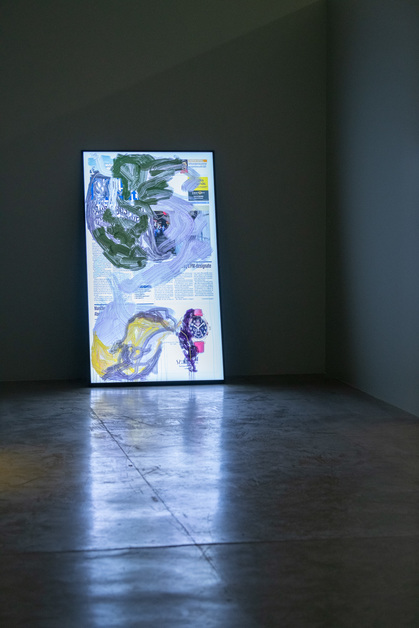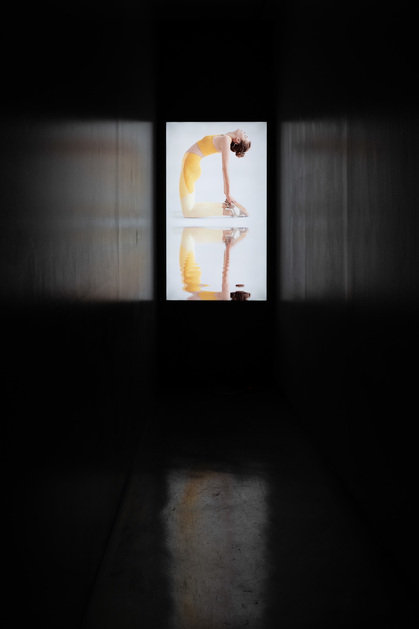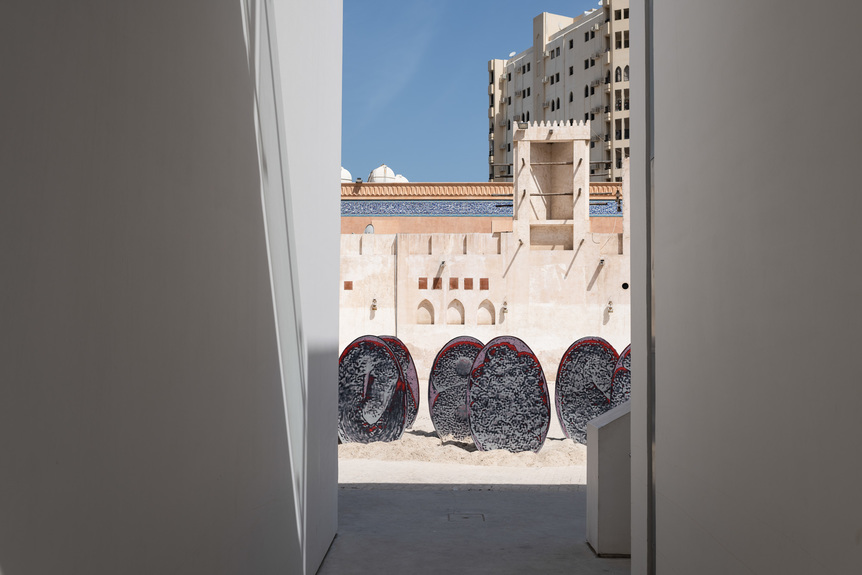-
From Current Issue
-
- Editor’s Letter Fire in the Heart
- Reviews I Gusti Ayu Kadek Murniasih
- Reviews 11th Seoul Mediacity Biennale: “One Escape at a Time”
- Dispatch Networked China
- One on One Monira Al Qadiri on Yukio Mishima
- Essays The rise of independent art spaces in pandemic-era Shanghai
- Features Tuan Andrew Nguyen
- Table of Contents
- Web Exclusives
- Archive
- Subscribe

R
E
V N
E
X
T
Installation view of JENNA SUTELA‘s nimiia cétiï, 2018, video installation: 12 min 4 sec, at “Art in the Age of Anxiety,” Sharjah Art Foundation, 2020. Created in collaboration with Memo Akten and Damien Henry as part of “n-dimensions,” Google Arts & Culture’s artist-in-residence program at Somerset House Studios, London. All photos by Danko Stjepanovic. Courtesy the artist.
“Art in the Age of Anxiety”: The Varieties of Addled Consciousness
Remember when we were merely anxious? Concerned about an incipient cataclysm that would throw our world into a gyre of mass death and financial ruin but still going about our lives? Status update: a lot has changed since 2019. The Sharjah Art Foundation (SAF)’s currently dormant exhibition, “Art in the Age of Anxiety,” curated by SAF director of collections and senior curator, Omar Kholeif, surveys the work of 30 international artists who address how the integration of technology into our daily lives has altered our collective consciousness and primed us for the waves of panic, misinformation, and bigotry that are rippling through societies during the Covid-19 pandemic.
“Age of Anxiety” centers around contemporary art produced in the 2010s, though several key internet-based projects by artists from Asia—notably Young Hae-Chang Heavy Industries’ web-based text animations using Flash and Cao Fei’s RMB City (2008–11)—were first activated online in the previous decade and subsequently updated for display in international exhibitions. Siebren Versteeg’s Daily Times (Performer: The National) (2020) is also an adaptation of his 2012 concept. Displayed on a vertical monitor, Daily Times takes the front page of Dubai’s English-language daily The National, and using acustom-designed algorithmic software, digitally transforms it into a messy abstraction of existential chaos, day after day.
Lest you yearn for the recent past, “Age of Anxiety” is a reminder of the pressing human-rights and privacy issues that are the legacy of the post-2001 “wars on terror.” Created in response to the British government’s practice of stripping individuals of citizenship over alleged connections to extremist groups, James Bridle’s Homo Sacer (2014) features a holographic virtual assistant who reads phrases from British and international law about the concept of citizenship. Other artists allude to the creeping invasion of privacy facilitated by new forms of technology. Douglas Coupland’s Delaware (2016), created when Facebook began using facial recognition software, portrays a face camouflaged by painted abstract forms. Expressing similar concerns about artificial intelligence, Trevor Paglen’s They Took the Faces from the Accused and the Dead . . . (2019) features early 20th century portraits from the American National Standards Institute that were, a century later, used to train facial recognition algorithms.
Virtual platforms have material histories, though we don’t often know or think about them. Cory Arcangel’s Yoga / Lakes (2017), a looping video of a woman in a yoga pose enhanced with a Java software script that creates a shimmery, reflective “lake effect” in the lower half of the screen, utilizes a piece of technology that never gained popularity and almost disappeared. Constant Dullaart’s Mirror PVA Formation, Shadow Cube Division (2019) is a square array of SIM-cards referring to the trade in armies of phantom social-media followers trafficked online.
Though not a primary component of the exhibition, several works reflect the the “post-internet” tendency of millennial artists, for whom life online was a significant part of growing up. Katja Novitskova, for instance, makes sculptures with digital prints that reference internet imagery, or that can even transform a physical space into what looks like a digitally-altered photograph, as in her installation of images depicting the C. elegans worm (used in medical science and biotech research), Pattern of Activation (Mutants) (2018). Digital natives of a previous generation, Eva & Franco Mattes riff on the unique culture of the internet in their light-hearted installation Catt (2010), which is based on a vintage meme of a cat inside a birdcage with a yellow finch sitting on top, captioned “EPIC FAIL.”
While few of the projects look into the future, for the video installation nimiia cétiï (2018), Jenna Sutela worked in collaboration with artist Memo Akten and Damien Henry of Google Arts & Culture to create a machine-learning program that combines the movements of the bacteria Bacillus subtilis with recordings of the French shaman Hélène Smith (who claimed to speak Martian) to form a new language. However incomprehensible to us, this fusion of non-human and alien intelligences suggests that the technological future perhaps rests in our overcoming our all-too-human flaws.
HG Masters is ArtAsiaPacific’s deputy editor and deputy publisher.
“Art in the Age of Anxiety” was scheduled to run at the Sharjah Art Foundation from March 21 to June 21, 2020. Please check the exhibition web page for up-to-date information in light of Covid-19.
To read more of ArtAsiaPacific’s articles, visit our Digital Library.

















